-
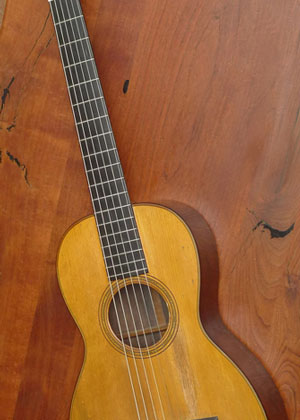 Considered by many to be most charming, intimate, 19th century Martin parlor guitar, the Martin 3-17 features Brazilian Rosewood back and sides, Adirondack spruce top, and Jerome tuners. This particular instrument, with an unbelievably beautiful, lyrical voice, was made in the early 1850’s, as we can tell by several clues. It’s a lot like Mark Twain’s famous Martin 2 ½-17 (see photo). Of course, it has to have the “CF Martin New York” not “CF Martin & Co” stamps– as this one does, to make it a pre-1867 Martin. Also, according to Martin scholars, Jerome tuners seem to have faded out by the late 1850s, to be replaced with similar tuners with a shorter plate and no name stamp. It is unusual on this guitar that the Jerome tuners are German silver, as most of the style 17 guitars have brass tuners. With the “tulip-shaped” tuner buttons, experts date the guitar to the early 1850s. The top is fan braced. Measurements are: body length 17.25″, lower bout width 11.125″, upper bout width 8.25″, overall length 35.75″, scale length just shy of 24 inches. 12 fret cedar neck with ice cream cone heel. Note that the black paint on the back of the neck and back of headstock was removed in some previous century– that does give a nice look at the cedar that would normally be obscured by the black “ebonized” paint. The body of the guitar had some overspray, but it turned out go be one of those fortunate occasions where it was light and really just sitting on top of the original finish, so we are able to easily remove it and reveal the original finish. A couple of small hairline cracks in back, repaired. Top and sides are crack-free. Reproduction ebony bridge. Original bar frets. Original Jerome Silver tuners, with original buttons. Original bracing and bridge plate. “C.F. MARTIN / NEW YORK” hot stamped on back, inside back brace and heel block (but the back stamp is faded). A previous owner of this guitar had a custom hard shell case made– it’s a professional quality, premium case that protects the guitar quite well– it’s heavy and sturdier than most new expensive hard shell cases. Historical interest aside (pre-civil war Martin guitars are rare), this guitar plays wonderfully. It projects the sweetest, but robust, glassy trebles, and clear mids and bass notes. It’s just a joy to play, and it just floats in your hands. (Note: 19th century Martins can be fitted with: gut strings, classical guitar strings, or extra light steel strings– depending on the guitar. It’s really a case-by-case basis, determining whether a particular 19th century Martin can “hold” or “withstand” very light gauge steel strings for example. One size does not fit all. And different 19th century Martins sound better with different strings. In this case, with this particular guitar, extra light steel strings are perfect. It can hold them fine– due to the structure of the top, the bridge plate, and bridge. And it plays and sounds perfect with those strings. This guitar is real find in that regard– not for the collector’s wall but for the player who wants to experience what the original CF Martin felt when he held this instrument in his hands in Nazareth, Pennsylvania, when Abraham Lincoln had not the slightest inkling he’d be in the White House and was just forging a reputation as an outstanding lawyer and earning the nickname of ‘Honest Abe’, and the New York Times was just commencing operations, and the first oil well had just been drilled in the United States by “Colonel” Edwin Drake in Titusville, Pennsylvania– that despite being in C.F. Martin’s state was darn near the old west at the time. In a custom made, professional quality hard shell case.
Considered by many to be most charming, intimate, 19th century Martin parlor guitar, the Martin 3-17 features Brazilian Rosewood back and sides, Adirondack spruce top, and Jerome tuners. This particular instrument, with an unbelievably beautiful, lyrical voice, was made in the early 1850’s, as we can tell by several clues. It’s a lot like Mark Twain’s famous Martin 2 ½-17 (see photo). Of course, it has to have the “CF Martin New York” not “CF Martin & Co” stamps– as this one does, to make it a pre-1867 Martin. Also, according to Martin scholars, Jerome tuners seem to have faded out by the late 1850s, to be replaced with similar tuners with a shorter plate and no name stamp. It is unusual on this guitar that the Jerome tuners are German silver, as most of the style 17 guitars have brass tuners. With the “tulip-shaped” tuner buttons, experts date the guitar to the early 1850s. The top is fan braced. Measurements are: body length 17.25″, lower bout width 11.125″, upper bout width 8.25″, overall length 35.75″, scale length just shy of 24 inches. 12 fret cedar neck with ice cream cone heel. Note that the black paint on the back of the neck and back of headstock was removed in some previous century– that does give a nice look at the cedar that would normally be obscured by the black “ebonized” paint. The body of the guitar had some overspray, but it turned out go be one of those fortunate occasions where it was light and really just sitting on top of the original finish, so we are able to easily remove it and reveal the original finish. A couple of small hairline cracks in back, repaired. Top and sides are crack-free. Reproduction ebony bridge. Original bar frets. Original Jerome Silver tuners, with original buttons. Original bracing and bridge plate. “C.F. MARTIN / NEW YORK” hot stamped on back, inside back brace and heel block (but the back stamp is faded). A previous owner of this guitar had a custom hard shell case made– it’s a professional quality, premium case that protects the guitar quite well– it’s heavy and sturdier than most new expensive hard shell cases. Historical interest aside (pre-civil war Martin guitars are rare), this guitar plays wonderfully. It projects the sweetest, but robust, glassy trebles, and clear mids and bass notes. It’s just a joy to play, and it just floats in your hands. (Note: 19th century Martins can be fitted with: gut strings, classical guitar strings, or extra light steel strings– depending on the guitar. It’s really a case-by-case basis, determining whether a particular 19th century Martin can “hold” or “withstand” very light gauge steel strings for example. One size does not fit all. And different 19th century Martins sound better with different strings. In this case, with this particular guitar, extra light steel strings are perfect. It can hold them fine– due to the structure of the top, the bridge plate, and bridge. And it plays and sounds perfect with those strings. This guitar is real find in that regard– not for the collector’s wall but for the player who wants to experience what the original CF Martin felt when he held this instrument in his hands in Nazareth, Pennsylvania, when Abraham Lincoln had not the slightest inkling he’d be in the White House and was just forging a reputation as an outstanding lawyer and earning the nickname of ‘Honest Abe’, and the New York Times was just commencing operations, and the first oil well had just been drilled in the United States by “Colonel” Edwin Drake in Titusville, Pennsylvania– that despite being in C.F. Martin’s state was darn near the old west at the time. In a custom made, professional quality hard shell case. -
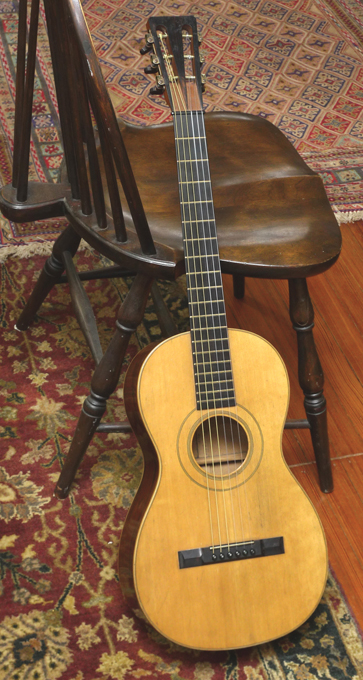 Circa 1860 parlor guitar style 1 built by well known luthier, James Ashborn of Wolcottville, CT, for William hall & son music store. Brazilian rosewood back and sides; Adirondack top; maple binding. This guitar is crack free save for a couple of minor finish cracks on back, and is 100% original, including all original finish, and down to original nut, original bridge (and saddle) that has never been off the guitar, and original bridge pins. From a just-published article in Vintage Guitar magazine: “Ashborn's design for the guitar was quite innovative for the early 19th century. Instead of making guitars fashioned after the typical parlor-style guitars, he made them in the Spanish style, by taking interior bracing cues from the Spanish while retaining the body of the English guitars. This included a fan brace pattern rather than the more common ladder pattern Ashborn guitars have a very complex dovetail V joint for attaching the head to the neck. The headstock was cut in roughly five steps, using some kind of tracing router, as suggested by the chatter marks on the inside ears of the pegbox. In addition to the complex head design, Ashborn made his own tuning machines in-house. They're made of brass, very much like contemporary machines, with worm gears, cog gears, and rollers. … Ashborn's shop was extremely advanced for its time, having a great deal of know-how and technology. Ashborn understood the need to have the technology as well as the skill, but more importantly he discovered a new way of making high-quality instruments that were affordable. He was able to create a factory environment where workers did what they were good at and, with practice, became very fast and consistent. With a new level of consistency in mass production, he created the path followed by other companies such as Martin, Gibson, and Taylor. Using designs ahead of his time, he was able to bring the sound and change to people who otherwise never would have been able to acquire an instrument of this quality.” This beautiful all-original and crack-free Ashborn guitar is one of the best-preserved examples in existence.
Circa 1860 parlor guitar style 1 built by well known luthier, James Ashborn of Wolcottville, CT, for William hall & son music store. Brazilian rosewood back and sides; Adirondack top; maple binding. This guitar is crack free save for a couple of minor finish cracks on back, and is 100% original, including all original finish, and down to original nut, original bridge (and saddle) that has never been off the guitar, and original bridge pins. From a just-published article in Vintage Guitar magazine: “Ashborn's design for the guitar was quite innovative for the early 19th century. Instead of making guitars fashioned after the typical parlor-style guitars, he made them in the Spanish style, by taking interior bracing cues from the Spanish while retaining the body of the English guitars. This included a fan brace pattern rather than the more common ladder pattern Ashborn guitars have a very complex dovetail V joint for attaching the head to the neck. The headstock was cut in roughly five steps, using some kind of tracing router, as suggested by the chatter marks on the inside ears of the pegbox. In addition to the complex head design, Ashborn made his own tuning machines in-house. They're made of brass, very much like contemporary machines, with worm gears, cog gears, and rollers. … Ashborn's shop was extremely advanced for its time, having a great deal of know-how and technology. Ashborn understood the need to have the technology as well as the skill, but more importantly he discovered a new way of making high-quality instruments that were affordable. He was able to create a factory environment where workers did what they were good at and, with practice, became very fast and consistent. With a new level of consistency in mass production, he created the path followed by other companies such as Martin, Gibson, and Taylor. Using designs ahead of his time, he was able to bring the sound and change to people who otherwise never would have been able to acquire an instrument of this quality.” This beautiful all-original and crack-free Ashborn guitar is one of the best-preserved examples in existence. -
Out of stock
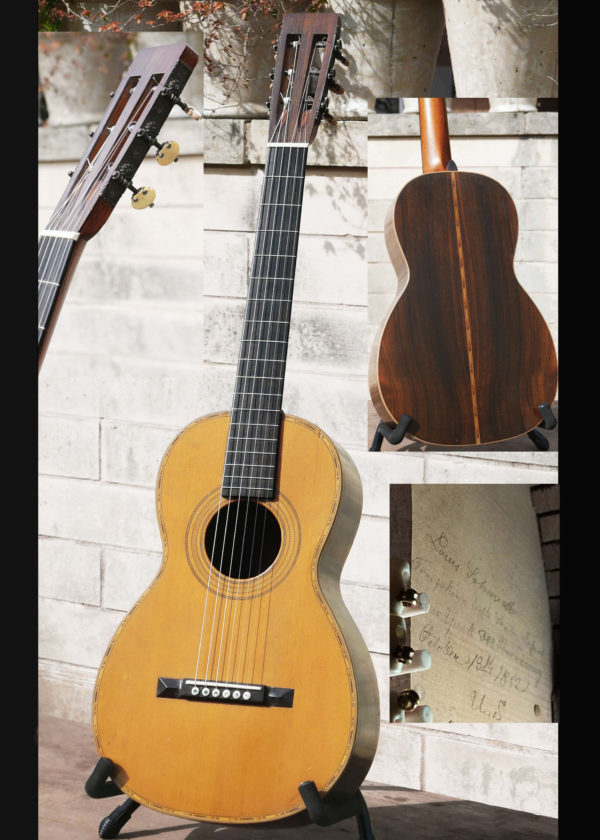 It’s beyond rare to find a guitar from the early Martin – Coupa - Schmidt – Maul – Schatz era in this state of preservation. And one this large. This rare model Schmidt & Maul guitar – by the original C.F. Martin's most famous colleagues and contemporaries– is signed and dated, October 18th, 1852, and is in its original coffin case. And best of all– it plays wonderfully, with low action. A unique piece of American guitar history– not for hanging on the wall but to play. The instrument is signed on the underside of the top: Louis Schmidt Tompkinsville Staten Island New York 388 Broadway October 18th 1852 U.S. This higher end, Spanish neck/heel (not ice-cream cone) Schmidt & Maul is bigger than all the Schmidt & Maul, Schmidt, or George Maul guitars that have come up for sale in the past decades (and not many of any kind have come up for sale). It’s a bit larger than a size 2 Martin, with a width at lower bout of 12 3/16 inches.(Every other Schmidt & Maul that has come to market has been a smaller guitar.) The guitar is braced inside (all original) with an early X-bracing variation similar to the 1953 Schmidt & Maul featured on p. 213 of the book “Inventing the American Guitar– The Pre-Civil War Innovations of C.F. Martin and His Contemporaries” edited by Robert Shaw and Peter Szego. (Hal Leonard Books, 2013). Like the 1853 guitar illustrated in that book, this guitar has bracing on top and back that is very close to the guitar that CF Martin and Schatz made for Madame de Goni. With all original finish, original ebony bridge, and original Jerome tuners– it’s in remarkable condition. To get the best of both worlds– historically authenticity and playability– the guitar has just had a recent neck set, original bridge reglue, and other minor work including new saddle, by one of the country’s top luthiers and authorities for early Martin and early American guitars– Steve Kovacik. All work was done by Steve to historically correct preservation standards after extensive examination and consultation. (Note, in the photo: the picture of the signature inside the guitar: the two cleats are not later repairs– rather they are two center seam-stabilizing cleats put in by the original luthiers in 1852.) Amazingly, this guitar plays in tune up and down the fretboard. Thank the original luthiers at 388 Broadway for that– they had the foresight to add slight compensation (not angled saddle compensation but cheating the saddle back a bit) to the bridge/saddle. Not even CF Martin did that in those years). And thanks to Steve Kovacik for setting this instrument up with low action not ballpark “19th century” action. The Adirondack top is crack-free. Crack-free sides. There are two almost imperceptible cracks on the back– you have to look hard to see them, both addressed by Steve Kovacik.
It’s beyond rare to find a guitar from the early Martin – Coupa - Schmidt – Maul – Schatz era in this state of preservation. And one this large. This rare model Schmidt & Maul guitar – by the original C.F. Martin's most famous colleagues and contemporaries– is signed and dated, October 18th, 1852, and is in its original coffin case. And best of all– it plays wonderfully, with low action. A unique piece of American guitar history– not for hanging on the wall but to play. The instrument is signed on the underside of the top: Louis Schmidt Tompkinsville Staten Island New York 388 Broadway October 18th 1852 U.S. This higher end, Spanish neck/heel (not ice-cream cone) Schmidt & Maul is bigger than all the Schmidt & Maul, Schmidt, or George Maul guitars that have come up for sale in the past decades (and not many of any kind have come up for sale). It’s a bit larger than a size 2 Martin, with a width at lower bout of 12 3/16 inches.(Every other Schmidt & Maul that has come to market has been a smaller guitar.) The guitar is braced inside (all original) with an early X-bracing variation similar to the 1953 Schmidt & Maul featured on p. 213 of the book “Inventing the American Guitar– The Pre-Civil War Innovations of C.F. Martin and His Contemporaries” edited by Robert Shaw and Peter Szego. (Hal Leonard Books, 2013). Like the 1853 guitar illustrated in that book, this guitar has bracing on top and back that is very close to the guitar that CF Martin and Schatz made for Madame de Goni. With all original finish, original ebony bridge, and original Jerome tuners– it’s in remarkable condition. To get the best of both worlds– historically authenticity and playability– the guitar has just had a recent neck set, original bridge reglue, and other minor work including new saddle, by one of the country’s top luthiers and authorities for early Martin and early American guitars– Steve Kovacik. All work was done by Steve to historically correct preservation standards after extensive examination and consultation. (Note, in the photo: the picture of the signature inside the guitar: the two cleats are not later repairs– rather they are two center seam-stabilizing cleats put in by the original luthiers in 1852.) Amazingly, this guitar plays in tune up and down the fretboard. Thank the original luthiers at 388 Broadway for that– they had the foresight to add slight compensation (not angled saddle compensation but cheating the saddle back a bit) to the bridge/saddle. Not even CF Martin did that in those years). And thanks to Steve Kovacik for setting this instrument up with low action not ballpark “19th century” action. The Adirondack top is crack-free. Crack-free sides. There are two almost imperceptible cracks on the back– you have to look hard to see them, both addressed by Steve Kovacik.- “Schmidt & Maul New York” stamps on neck block, and center strip inside guitar
- X-braced, all original braces inside
- Spanish foot construction
- Radiused Ebony fretboard
- All historically correct bar fret replacement by Steve Kovacik (not too high, and not too thick– correct size bar frets were used, properly finished)
- Original bridge plate, in fine condition
- Original Jerome tuners and buttons
- Original nut, and saddle, in case. New nut and saddle by Steve Kovacik
- Rosette: shares a feature with early Martins– a variant of the "tooth" rosette– a three ring rosette with green "tooth" inner ring, and small "rope" outer rings
- Marquetry Purfling around top, + Maple binding
- Back purfling (backstrip): see Martin Guitars: A Technical Reference, p. 13: this is a “Pre-1867 style 34” Martin style purfling
- Maple binding, back
- Solid Adirondack top
- Solid brazilian rosewood back and sides
- Cedar, Spanish style neck and heel
- Width at lower bout: 12 3/16 inches
- Body length: 18 ¼ inches
- Nut width: 1 15/16 inches
- String spacing at bridge: 2 5/16
- Scale length: 24 ½ inches (But there is a slight compensation: 12th fret to the saddle– Schmidt and Maul added a touch of compensation !
- Original scooped-back ebony bridge
- 100% original finish. No overspray, touch-up, etc. anywhere…wonderful finish
-
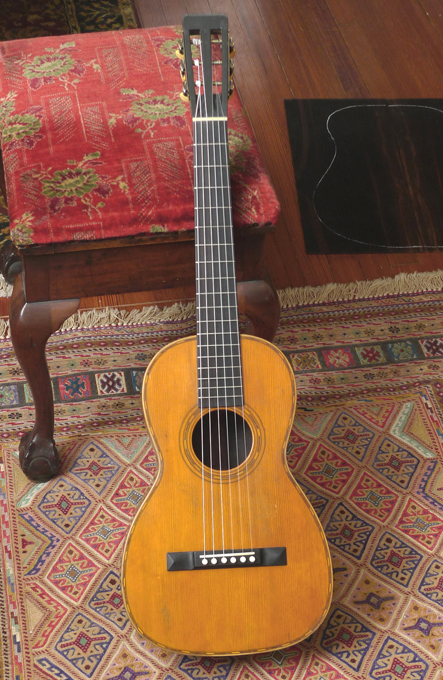 A rare, wonderfully-preserved, 1854 Schmidt & Maul. It’s signed and dated inside: Louis Schmidt Tompkinsville Staten Island New York 388 Broadway August 18th 1854 U. S.
A rare, wonderfully-preserved, 1854 Schmidt & Maul. It’s signed and dated inside: Louis Schmidt Tompkinsville Staten Island New York 388 Broadway August 18th 1854 U. S.- Adirondack top
- Ebonized “ice cream cone” style neck
- solid brazilian rosewood back and sides
- fan braced
- marquetry Purfling around top, with Maple binding
- Maple binding, back
- Width at lower bout: 11 ½ inches
- 100% original finish. No overspray, touch-up, etc. anywhere…wonderful finish
- Not a crack on top, or sides. One small dryness crack on back, near the edge binding on treble side
- Original bridge plate, in great condition
- Reproduction, correct, Ebony bridge
- Bar frets replaced with period correct Bar frets from TJ Thompson
-
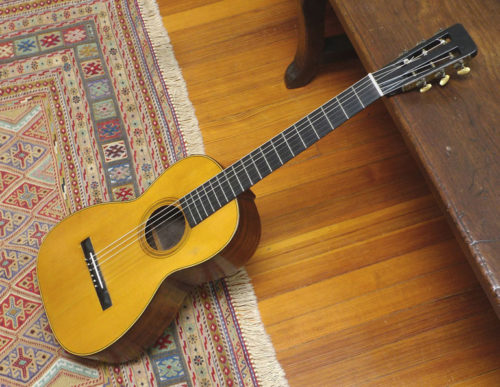 This guitar is the last known guitar in existence, made by Louis Schmidt, the famous contemporary and one-time colleague to the founder of Martin Guitars, the original C.F. Martin. As such, it is a rare example of early American guitar making. And it’s signed by the maker, on the underside of the Adirondack top: Louis Schmidt Wakefield Westchester Cy NY July 9th 1859 U.S. Louis Schmidt worked side by side with CF Martin in the early years. Perhaps the most common misconception about early American guitar history is that C. F. Martin spent his first years in America earning a living as a solitary luthier in his New York workshop. Pay ledgers reveal that as early as 1834 he was paying luthiers to help him make his guitars. Two of these men, Heinrich Schatz and Louis Schmidt, left Martin's employ to make guitars on their own, and each succeeded as top builders. This instrument:
This guitar is the last known guitar in existence, made by Louis Schmidt, the famous contemporary and one-time colleague to the founder of Martin Guitars, the original C.F. Martin. As such, it is a rare example of early American guitar making. And it’s signed by the maker, on the underside of the Adirondack top: Louis Schmidt Wakefield Westchester Cy NY July 9th 1859 U.S. Louis Schmidt worked side by side with CF Martin in the early years. Perhaps the most common misconception about early American guitar history is that C. F. Martin spent his first years in America earning a living as a solitary luthier in his New York workshop. Pay ledgers reveal that as early as 1834 he was paying luthiers to help him make his guitars. Two of these men, Heinrich Schatz and Louis Schmidt, left Martin's employ to make guitars on their own, and each succeeded as top builders. This instrument:- Similar features to circa 1860 Martin 17 style... but different purfling, binding, and slightly different body shape
- All original finish
- Brazilian rosewood back and sides (solid); Adirondack top
- In its original coffin case
- 11 3/8 inches wide at lower bout (a bit larger than a Martin 2 1/2)
- Body: 3 7/8 inches deep
- Original mahogany bridge plate (goes almost all the way across the width of the top, slotted under all the braces)
- Fan bracing pattern
- Plays beautifully. Good bass tone. Action is perfect.
- Ebony Bridge has been off at some point, and reglued on. With a lack of similar guitars on the market, it’s not known if this 19th century bridge on the instrument is the original bridge.
- One repaired crack on top, from bridge to bottom binding; One repaired crack on back. One small crack on top, either top edge of soundhole.
- Original Jerome tuners, reverse gear, working perfectly
- Maple and rosewood purfling/binding on top (no binding on back)
-
Out of stock
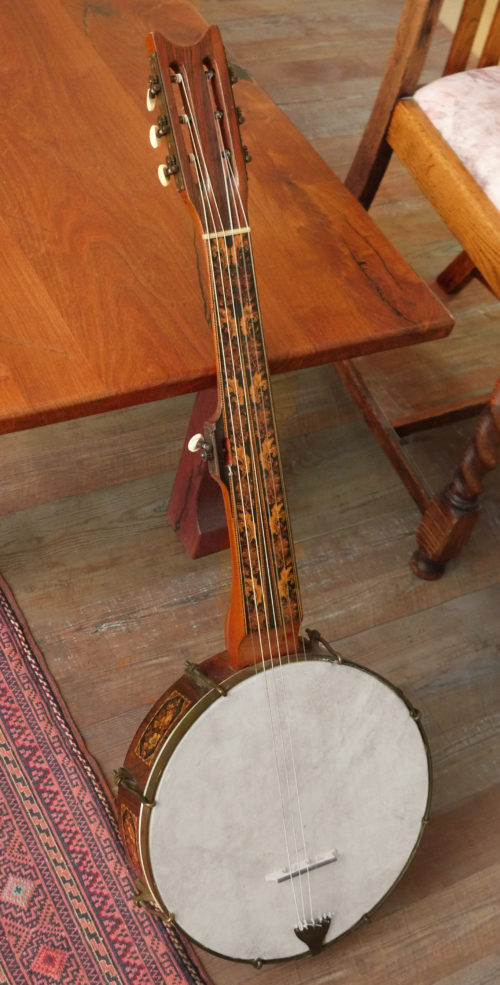 A rare and amazingly original English, Tunbridge ware fretless 7 string banjo. Circa 1850-60. This instrument is 100% original, and even the tailpiece is the original brass tailpiece. This banjo is also rare in that it has original geared tuning machines, not pegs like other examples from the period. The Tunbridge ware banjo is almost impossible to find in this condition and stage of originality. And Tunbridge’s are rare, period. The history? After Joel Sweeney – born to a farming family in Appomattox, Virginia and claimed to have learned to play the banjo from local African population, and the earliest known person to have played the banjo on stage – embarked on a European tour that included stops in London and Edinburgh. He played there for several months, and raised awareness of the instrument in England. As in the U.S., banjos began to be made by local craftsmen – they were still hand made and came in all shapes and sizes, with 5, 6, 7 and even 12 strings, and with one or more drone strings, sometimes on both sides of the neck. Only a few, best ones, such as this instrument, had an amazing amount of work put into them, none more so than those made by a very few firms centered around Tunbridge Wells in Kent, where the local craftsmen specialized in producing a particular form of Treen ware, made from up to 180 different colored woods. Holly, cherry, plum, yew, sycamore, and even imported lignum vitae were all used. The technique was to bind short lengths together and glue them into bundles so when viewed end on, a pattern or picture could be seen. Instrument length: 34 inches. With a 12 inch pot. Eight tensioners and shoes, all original. Original, rare circa 1850 German brass machine tuners (one bent shaft– but still operates perfectly). Original brass tailpiece. Fingerboard, and pot, consisting of inlaid woods as geometric patterns. All the inlays are intact. $2450. In a modern case.
A rare and amazingly original English, Tunbridge ware fretless 7 string banjo. Circa 1850-60. This instrument is 100% original, and even the tailpiece is the original brass tailpiece. This banjo is also rare in that it has original geared tuning machines, not pegs like other examples from the period. The Tunbridge ware banjo is almost impossible to find in this condition and stage of originality. And Tunbridge’s are rare, period. The history? After Joel Sweeney – born to a farming family in Appomattox, Virginia and claimed to have learned to play the banjo from local African population, and the earliest known person to have played the banjo on stage – embarked on a European tour that included stops in London and Edinburgh. He played there for several months, and raised awareness of the instrument in England. As in the U.S., banjos began to be made by local craftsmen – they were still hand made and came in all shapes and sizes, with 5, 6, 7 and even 12 strings, and with one or more drone strings, sometimes on both sides of the neck. Only a few, best ones, such as this instrument, had an amazing amount of work put into them, none more so than those made by a very few firms centered around Tunbridge Wells in Kent, where the local craftsmen specialized in producing a particular form of Treen ware, made from up to 180 different colored woods. Holly, cherry, plum, yew, sycamore, and even imported lignum vitae were all used. The technique was to bind short lengths together and glue them into bundles so when viewed end on, a pattern or picture could be seen. Instrument length: 34 inches. With a 12 inch pot. Eight tensioners and shoes, all original. Original, rare circa 1850 German brass machine tuners (one bent shaft– but still operates perfectly). Original brass tailpiece. Fingerboard, and pot, consisting of inlaid woods as geometric patterns. All the inlays are intact. $2450. In a modern case. -
Out of stock
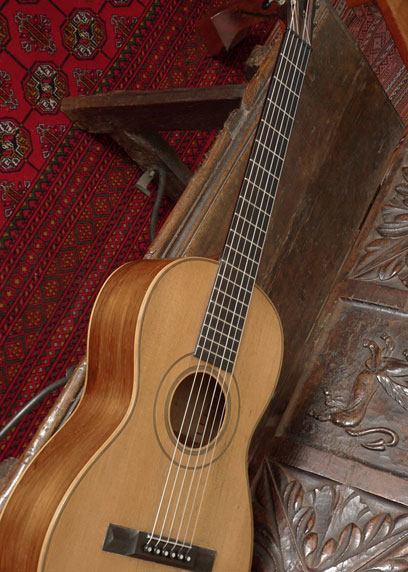 Circa 1860 guitar, style 3 built by well known luthier James Ashborn of Wolcottville, CT, for William Hall & Son music store. Brazilian rosewood back and sides; Adirondack top; maple binding. Rare Brazilian rosewood veneered neck. 100% original, including all original finish, and down to original nut, original bridge (and saddle) that has never been off the guitar. From an article in Vintage Guitar magazine: "Ashborn's design for the guitar was quite innovative for the early 19th century. Instead of making guitars fashioned after the typical parlor-style guitars, he made them in the Spanish style, by taking interior bracing cues from the Spanish while retaining the body of the English guitars. This included a fan brace pattern rather than the more common ladder pattern Ashborn guitars have a very complex dovetail V joint for attaching the head to the neck. The headstock was cut in roughly five steps, using some kind of tracing router, as suggested by the chatter marks on the inside ears of the pegbox. In addition to the complex head design, Ashborn made his own tuning machines in-house. They're made of brass, very much like contemporary machines, with worm gears, cog gears, and rollers. … Ashborn's shop was extremely advanced for its time, having a great deal of know-how and technology. Ashborn understood the need to have the technology as well as the skill, but more importantly he discovered a new way of making high-quality instruments that were affordable. He was able to create a factory environment where workers did what they were good at and, with practice, became very fast and consistent. With a new level of consistency in mass production, he created the path followed by other companies such as Martin, Gibson, and Taylor. Using designs ahead of his time, he was able to bring the sound and change to people who otherwise never would have been able to acquire an instrument of this quality."
Circa 1860 guitar, style 3 built by well known luthier James Ashborn of Wolcottville, CT, for William Hall & Son music store. Brazilian rosewood back and sides; Adirondack top; maple binding. Rare Brazilian rosewood veneered neck. 100% original, including all original finish, and down to original nut, original bridge (and saddle) that has never been off the guitar. From an article in Vintage Guitar magazine: "Ashborn's design for the guitar was quite innovative for the early 19th century. Instead of making guitars fashioned after the typical parlor-style guitars, he made them in the Spanish style, by taking interior bracing cues from the Spanish while retaining the body of the English guitars. This included a fan brace pattern rather than the more common ladder pattern Ashborn guitars have a very complex dovetail V joint for attaching the head to the neck. The headstock was cut in roughly five steps, using some kind of tracing router, as suggested by the chatter marks on the inside ears of the pegbox. In addition to the complex head design, Ashborn made his own tuning machines in-house. They're made of brass, very much like contemporary machines, with worm gears, cog gears, and rollers. … Ashborn's shop was extremely advanced for its time, having a great deal of know-how and technology. Ashborn understood the need to have the technology as well as the skill, but more importantly he discovered a new way of making high-quality instruments that were affordable. He was able to create a factory environment where workers did what they were good at and, with practice, became very fast and consistent. With a new level of consistency in mass production, he created the path followed by other companies such as Martin, Gibson, and Taylor. Using designs ahead of his time, he was able to bring the sound and change to people who otherwise never would have been able to acquire an instrument of this quality." -
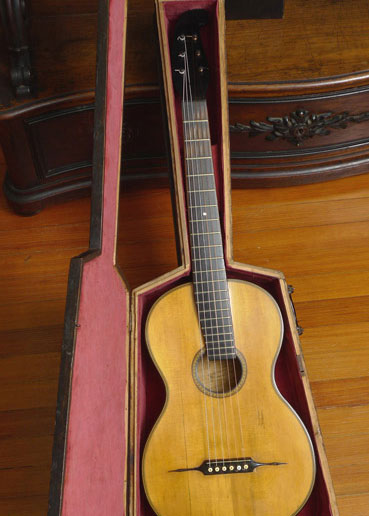 Read the full description below. If you're interested in this guitar, please call 512.922.8596 or contact us here.
Read the full description below. If you're interested in this guitar, please call 512.922.8596 or contact us here. -
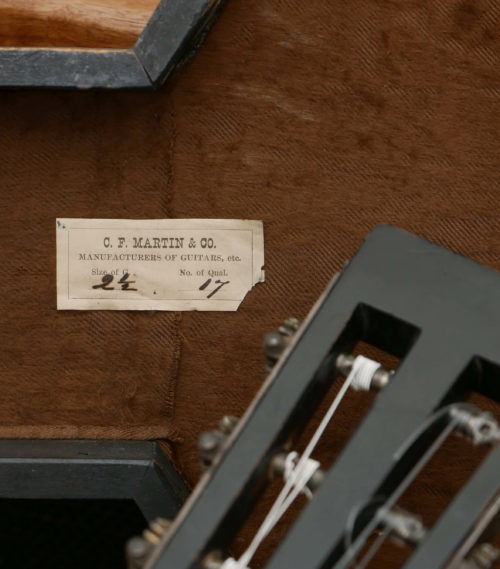 19th century Martin parlor guitar. This lovely sounding Martin 2 1/2-17 features solid Brazilian Rosewood back and sides, Adirondack spruce top, and original Jerome tuners. This particular instrument has a beautiful, lyrical voice. It was made probably circa 1867-1870. There are several clues to establish that: the original coffin case with the guitar has attributes of an earlier case: the small brass handle, and the label inside the case has font and other attributes of late a 1860s case. Also, the particular style of the original Jerome Tuners. Kerfing inside is also indicative of an 1860’s Martin. And, the best clue of all: the 1 ¾ inch nut width. Of course, it’s post-1867, because of the “CF Martin & Co” stamps inside. The top is fan braced, typical of this style. Measurements are: body length 17 7/8", lower bout width 11 5/8", overall length 36 1/2"; scale length 24 ½ inches. 4 inch body depth at end pin; 3 3/8 inch boy depth at neck joint. 1 ¾ inch nut width– may have been a custom order, or just a slightly narrower nut width (from the 1 7/8 more common later) from the factory. 12 fret cedar neck/ebonized, with ice cream cone heel. All original finish, everywhere. A fair-to-low amount of playwear (see photos). Original bar frets in fine condition. Several small hairline cracks in back, repaired. Top and sides also have a couple or repaired cracks. Reproduction ebony bridge– just made by Dick Dubois.. Original bar frets. Original bracing. "C.F. MARTIN &CO/ NEW YORK" hot stamped on back strip inside, and heel block. CF Martin New York stamped on back, by heel joint. Original Jerome tuners, with original buttons– note, one of the sun gears (on the G string tuner) has been replaced, with a different 19th century Martin sun gear (see photo). Historical interest aside (these just-post-civil war Martin guitars are more rare than the 1870’s/1880’s/1890’s examples), this guitar plays wonderfully. It projects glassy brazilian trebles, and clear mids and bass notes. It’s just a joy to play, and it just floats in your hands (due to its very light weight). Action is good, and it plays in tune even on the higher frets. (Note: 19th century Martins can be fitted with: gut strings, classical guitar strings, or sometimes silk and steel/tuned down–depending on the guitar. It’s really a case-by-case basis. One size does not fit all. And different 19th century Martins sound better with different strings. In this case, with this particular guitar, our favorite strings if you want a “classical” style string but more brightness and volume than nylon classical strings: Savarez Alliance composite High Tension strings (note, “high tension” by classical standards– fine for this instrument). This instruments sounds wonderful with those strings. In is original coffin case (and case has all the original hardware, as well as its original cloth interior lining).
19th century Martin parlor guitar. This lovely sounding Martin 2 1/2-17 features solid Brazilian Rosewood back and sides, Adirondack spruce top, and original Jerome tuners. This particular instrument has a beautiful, lyrical voice. It was made probably circa 1867-1870. There are several clues to establish that: the original coffin case with the guitar has attributes of an earlier case: the small brass handle, and the label inside the case has font and other attributes of late a 1860s case. Also, the particular style of the original Jerome Tuners. Kerfing inside is also indicative of an 1860’s Martin. And, the best clue of all: the 1 ¾ inch nut width. Of course, it’s post-1867, because of the “CF Martin & Co” stamps inside. The top is fan braced, typical of this style. Measurements are: body length 17 7/8", lower bout width 11 5/8", overall length 36 1/2"; scale length 24 ½ inches. 4 inch body depth at end pin; 3 3/8 inch boy depth at neck joint. 1 ¾ inch nut width– may have been a custom order, or just a slightly narrower nut width (from the 1 7/8 more common later) from the factory. 12 fret cedar neck/ebonized, with ice cream cone heel. All original finish, everywhere. A fair-to-low amount of playwear (see photos). Original bar frets in fine condition. Several small hairline cracks in back, repaired. Top and sides also have a couple or repaired cracks. Reproduction ebony bridge– just made by Dick Dubois.. Original bar frets. Original bracing. "C.F. MARTIN &CO/ NEW YORK" hot stamped on back strip inside, and heel block. CF Martin New York stamped on back, by heel joint. Original Jerome tuners, with original buttons– note, one of the sun gears (on the G string tuner) has been replaced, with a different 19th century Martin sun gear (see photo). Historical interest aside (these just-post-civil war Martin guitars are more rare than the 1870’s/1880’s/1890’s examples), this guitar plays wonderfully. It projects glassy brazilian trebles, and clear mids and bass notes. It’s just a joy to play, and it just floats in your hands (due to its very light weight). Action is good, and it plays in tune even on the higher frets. (Note: 19th century Martins can be fitted with: gut strings, classical guitar strings, or sometimes silk and steel/tuned down–depending on the guitar. It’s really a case-by-case basis. One size does not fit all. And different 19th century Martins sound better with different strings. In this case, with this particular guitar, our favorite strings if you want a “classical” style string but more brightness and volume than nylon classical strings: Savarez Alliance composite High Tension strings (note, “high tension” by classical standards– fine for this instrument). This instruments sounds wonderful with those strings. In is original coffin case (and case has all the original hardware, as well as its original cloth interior lining). -
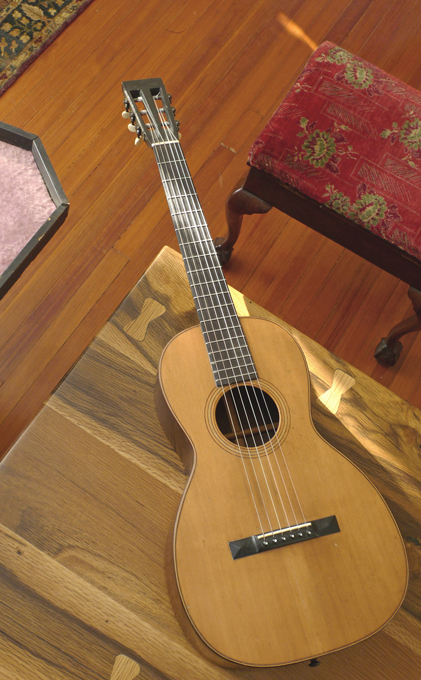 Another all-original pre-war Martin… but you have to go back a few more wars on this one- to just after the Civil War. This guitar even has its original coffin case–necessary in the days when Martin guitars were shipped out by railroad or wagon train. The figured Brazilian rosewood back and sides are unusual– in these decades of the 19th century (and through the middle of the 20th) Martin usually did not use this kind of figured, lovely Brazilian (they preferred the more straight-grained variety). On this guitar, for the sake of originality, we’ve kept its original saddle intact. The original ivory saddle is worn through at the strings, but still functions nicely.
Another all-original pre-war Martin… but you have to go back a few more wars on this one- to just after the Civil War. This guitar even has its original coffin case–necessary in the days when Martin guitars were shipped out by railroad or wagon train. The figured Brazilian rosewood back and sides are unusual– in these decades of the 19th century (and through the middle of the 20th) Martin usually did not use this kind of figured, lovely Brazilian (they preferred the more straight-grained variety). On this guitar, for the sake of originality, we’ve kept its original saddle intact. The original ivory saddle is worn through at the strings, but still functions nicely.- Fan braced
- Adirondack top
- Ebonized “ice cream cone” style neck
- Solid Brazilian rosewood back and sides
- 100% original finish…. No overspray, touch-up, etc. anywhere…wonderful finish
- Original ebony bridge, and bridge plate
- Two cracks in spruce top; one is bridge to bottom of top; the other is from near bridge to soundhole; first one described is beneath an internal brace; second is 2mm adjacent to a different brace. Neither need attention and are left alone to preserve originality.
- Characteristic, three Martin stamps: “CF Martin & Co, New York” ink stamped on neck block; “CF Martin & Co, New York” ink stamped on center strip inside; and “CF Martin New York”, stamped/pressed into brazilian rosewood back of guitar, up near the heel. (note: this guitar is not signed personally by factory foreman, etc, on underside of top…. This fact, and the other details, points to a circa 1870 date, not 1880s or 90’s).
-
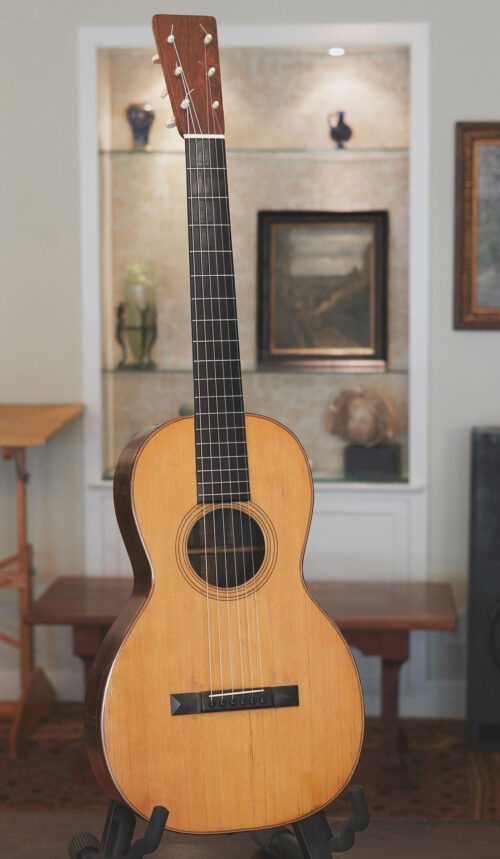
In this period (any Martin guitar made before 1898) there were of course no serial numbers on Martins, and no one signed the instruments inside with a date as they often did in the later 1880’s. But it has all the hallmarks of 1870s to mid-1880’s – and most likely earlier in that period, about 1870, judging by the endstrip material.
It has the original friction tuners – with the exception of the Low E string tuner that was missing and so has been replaced (probably a hundred years ago) with a tuning peg to match the originals.
The size 2 is a great size, it’s a larger guitar than the more common size 2 ½ from this era.
Amazing tone from this guitar. See and hear this guitar being played:
All careful work has been done on this guitar, and it won’t need anything else – it’s a great guitar for the player who wants the best Martin tone and playability – a tonal gem from the 19th century Martin factory in Nazareth.
• Spruce top over Brazilian Rosewood back and sides.
• Spanish heel (not the ice cream cone heel of the less expensive Martins)
• Peg head, with original tuners (with one replacement– the high E string peg)
• Light overspray on top done ages ago, so it’s not very noticeable.
A bit more overspray on back and sides, done decades and decades ago.
• Fan braced – as are most of the best sounding Martins from this era.
• Original thin maple bridge plate
• Original ebony fretboard; Original bar frets with some wear but they’re still pretty high.
• Soft V neck
• Scale length: 24.5 inches
• Width at lower bout: 12 inches
• Nut width: 1 13/16 inch
Multiple cracks on top, all repaired (see photos); multiple cracks on back, all repaired.
Heel has a tiny crack – but it looks like there was never any separation, more of surface crack (see photos)
Two areas by top edge of bridge, either end, where wood was splintered a bit, now repaired and stable. (See photos)
This guitar has seen multiple crack repairs, but it’s structurally sound now, and needs no work going forward. It’s priced low to reflect the work done. It has marvelous sound and projection, and plays with great low action and great intonation all up and down the fretboard. Strung with Savarez Alliance strings.
It would be a great addition to a player wanting a superb example of the best Martin sound from the 19th century – at an affordable cost that’s impossible to find in today’s market.
Ships in a modern hard shell case.
Price: $4,850. – plus shipping
-
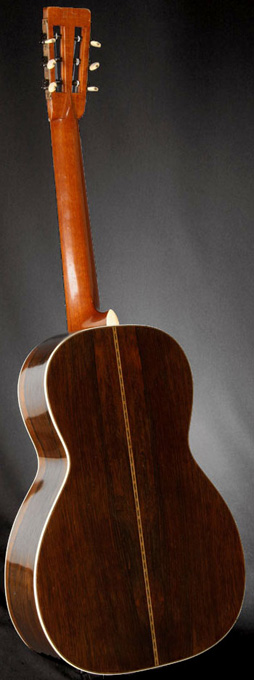 Signed by Martin factory foreman, underside of top: “6/1886”, this 0-28 is in stunning original condition. 1886 is the last year of the original factory in Nazareth, before Martin built the new factory addition in 1887. It is also the last year before they installed mechanized steam-run equipment to bend sides. So this wonderful 0-28, is one of the last of the totally hand-crafted Martins, built without mechanized equipment, and signed as such, 1886. Instrument is 100% original: finish, bridge, ivory nut, ivory saddle, ivory pins, bar frets, everything.
Signed by Martin factory foreman, underside of top: “6/1886”, this 0-28 is in stunning original condition. 1886 is the last year of the original factory in Nazareth, before Martin built the new factory addition in 1887. It is also the last year before they installed mechanized steam-run equipment to bend sides. So this wonderful 0-28, is one of the last of the totally hand-crafted Martins, built without mechanized equipment, and signed as such, 1886. Instrument is 100% original: finish, bridge, ivory nut, ivory saddle, ivory pins, bar frets, everything.- Crack-free
- repaired center seam on top
- Shows very little wear
- Scalloped braces (X-braced)
- original maple bridge plate
- original French-polish shellac finish throughout
- 13.5" wide at lower bout, and 4.25" deep at the endpin
- 24.9" scale length
- 1-7/8" wide nut
- soft-V neck profile.